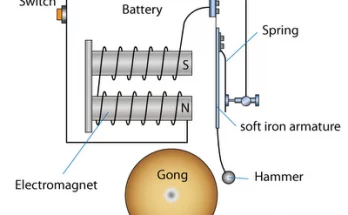Objective- This activity helps students understand the heating effect of electric current, particularly how a bulb heats up when electric current flows through it.
Concepts to Understand
- Heating Effect of Electric Current- When electric current flows through a conductor (like the filament of a bulb), it generates heat. This is due to the resistance offered by the conductor to the flowing current.
Materials Needed-
- An electric cell
- A bulb
- A switch
- Connecting wires
Steps to Follow-
- Assemble the Circuit-
- Connect one wire from the positive terminal of the cell to one terminal of the switch.
- Attach another wire from the second terminal of the switch to one terminal of the bulb.
- Connect a third wire from the other terminal of the bulb to the negative terminal of the cell.
- Ensure that all connections are secure and that the switch is initially in the ‘OFF’ position.
- Observing the Bulb–
- Before turning on the switch, touch the bulb to feel its temperature.
- Now, move the switch to the ‘ON’ position and allow the bulb to glow for about a minute.
- After a minute, carefully touch the bulb again (be cautious as it might be hot).
- Recording Observations-
- Note the difference in the temperature of the bulb before and after the current was allowed to flow.
- Turn off the switch, wait for a while, and touch the bulb again to observe any temperature change.
Understanding the Concept-
- When the switch is turned ‘ON’, electric current flows through the bulb’s filament.
- The filament offers resistance to the flow of electric current, and this resistance causes the filament to heat up, making the bulb warm to the touch.
- When the switch is turned ‘OFF’, the current stops flowing, and the bulb starts to cool down.
Conclusion-
Through this activity, students learn about the heating effect of electric current. They observe how the electric current can cause a conductor to heat up, which is a principle used in many everyday appliances like electric heaters, toasters, and even light bulbs. Understanding this effect is crucial in grasping how various electrical devices operate and the importance of electrical safety.
Also Check – Chapter 10: A Detailed Guide to “Electric Current and its Effects” Activities for Class 7 Students
Also Check- Electromagnets- A Guide for Upper Primary Students
Also Check- Chapter 10 – Electric Current and its Effects – 5 Worksheets Solved and Unsolved
Also Check- Electric Bell Diagram for Class 7 Science
Also Check- Rapid Revision – Class 7 Science- Chapter 14 – Electric Current and Its Effects
Also Check- Chapter 14- Electric Current and Its Effects-Class 7 science- Question and Answers
Also Check- Chapter 14- Electric Current and Its Effects–Class 7 science- Question and Answer -(Solved MCQs)
Also Check- NCERT Exemplar Solutions- Class 7 Science- Chapter 14 – Electric Current and Its Effects
Also Check- NCERT Solutions for Class 7 Science Chapter 14- Electric Current and its Effects
Also Check- Class 7 science -Chapter 14 – Electric Current and Its Effects- Complete Notes
Also Check – Electric Bell Working Mechanism Simplified for Students
Also Check- Batteries- The Powerhouses of Everyday Life – A Guide for Upper Primary Students

